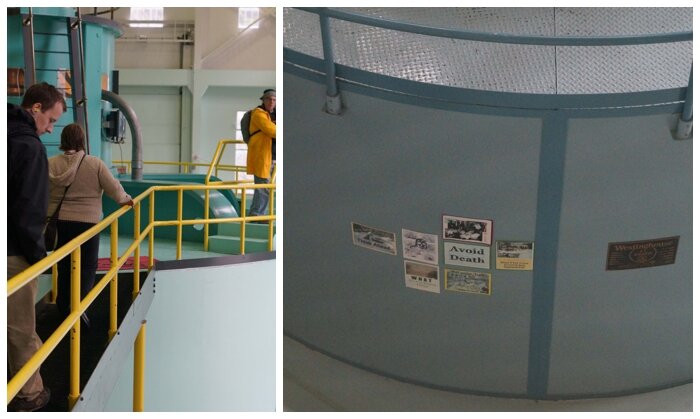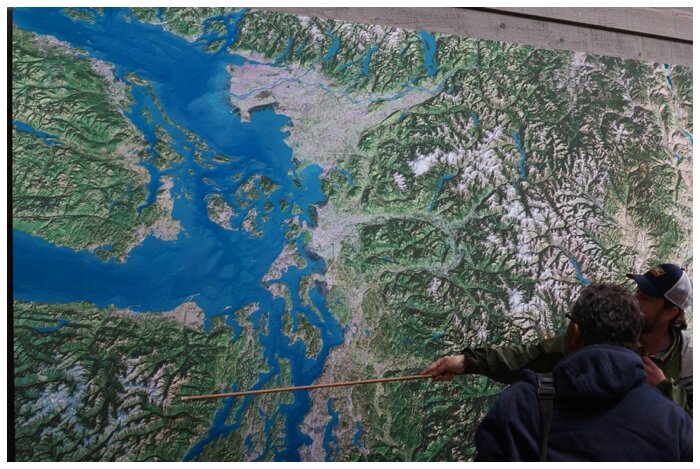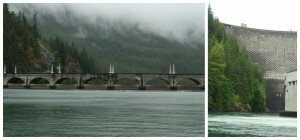Photographer Kat Thorney and I joined a cadre of regional journalists for an all-inclusive media day at the Skagit River Hydroelectric Project on June 20. The trip showcased the variety of tours offered by Seattle City Light, the power company that provides 20 percent of Seattle's electricity from the three dams they operate in the North Cascades (also known as the American Alps).
Our tour began in Newhalem, Seattle City Light's company town, and from there we were guided to the uppermost dam at the foot of Ross Lake and a lunch provided by the North Cascades Institute (NCI). We also took a boat ride on Diablo Lake and tours of various powerhouses and dams along the way. The fascinating history behind the dams, the majesty of the rugged terrain in which they were built and collaboration with the North Cascades National Park and the NCI make the tours offered by Seattle City Light a worthwhile way to spend a day in the mountains – even if, like us, you go on a rainy day.
From left to right, Michael Aronowitz, Christian Martin and Andrew Pringle were our guides for the day. Michael is a senior environmental analyst for Seattle City Light. Christian is NCI's communications manager. Andrew, if you couldn't tell by his awesome hat, is a ranger for North Cascades National Park.
The tour started in Newhalem, one of only a few remaining company towns in the country. Most of its several dozen residents are employees of Seattle City Light. The craftsmen-era houses of the village are precisely laid out and, these days, mostly empty. Just upstream from the village is the Gorge Powerhouse. It's the smallest of the three powerhouses, but produces the most consistent power due to its newer and more efficient fourth generator. The Skagit enters a tunnel a mile upstream. The tunnel tapers to increase the force of water hitting the turbines of the generators inside the neoclassic building.
Ross was a genius of marketing as well as engineering.
The picture above on the right shows the backside of the powerhouse, which is tucked against a rocky hillside. This was in part to take advantage of geothermal cooling - the shaded mountainside helps cool the building and the generators inside. Ross came up with the idea, and it's likely he was behind another cool flash of brilliance that allowed the Gorge tunnel to be dug.
Engineers needed to temporarily dam the river to dig the tunnel, but all efforts were thwarted because the river kept leaking under whatever was piled on top of it. The riverbed was pure sludge, and bedrock was too far down to seal the dam. Engineers pumped a supercooled saltwater solution deep into the earth, which froze the leaking river and created an ice dam. They kept the dam frozen long enough to complete the project.
Ross also wanted the project to attract tourism as a means of promotion, so he strived to make it as beautiful as possible. He became an amateur botanist in his efforts, and beautiful gardens still grace the buildings at every turn. He brought in hundreds of exotic animals. He also installed an electric forest, an illuminated walkway through the trees along Ladder Creek Falls above the Gorge powerhouse. The path was dappled with colorful lights at night, and popular music entertained tourists, who came to the project by the trainload to witness the wonders of hydroelectric power.
 The trains and gardens of Newhalem make for a pleasant walking tour.
The trains and gardens of Newhalem make for a pleasant walking tour.From the Gorge Powerhouse we were vanned up to the Diablo Powerhouse. We toured the loud and impressive generator room, and walked along the catwalks on top of the cylindrical generator housings.
 The poster on the far right shows people stumbling around with pumpkins on their heads, with a caption that reads, "Don't squash your gourd." Between that and the advice to "Avoid Death," I think the engineers are up to OSHA standards.
The poster on the far right shows people stumbling around with pumpkins on their heads, with a caption that reads, "Don't squash your gourd." Between that and the advice to "Avoid Death," I think the engineers are up to OSHA standards.The topography of the North Cascades is extremely steep. We were surrounded by the sheer walls of a gorge throughout the tour, and the further east we went the narrower and steeper the gorge became. For the engineers who built the dams, the topography posed a significant challenge to transporting workers and materials to the upper dams. This unusual lift (pictured at left) was their solution. Rail cars were uncoupled at the bottom, pulled onto a short track and raised one at a time, then pulled onto another rail and re-coupled at the top. The lift used cables and a heavy counterweight to lift each car. It was still in operation as late as 2004, but due to the uniqueness of the system, replacing worn parts became cost prohibitive. Today, it is no longer used because it was reclassified as an elevator by the Department of Labor and Industries, and it doesn't meet industry elevator standards.
 Christian points out the Olympic Peninsula on a satellite image of northwest Washington, which graces an exterior wall of the NCI Environmental Learning Center
Christian points out the Olympic Peninsula on a satellite image of northwest Washington, which graces an exterior wall of the NCI Environmental Learning CenterAfter the Diablo Powerhouse tour, we drove over the top of Diablo Dam, which drops 389 feet to the riverbed below. In 1930, when the dam was built, it was the tallest in the world.
At NCI, Christian told us about the Institute before treating us to a world-class lunch buffet. NCI is all about environmental sustainability. They offer immersive educational experiences ranging from interpretive weekends for vacationers up to a master's program in environmental education. In keeping with their green ways, the chefs at NCI use only the freshest, locally-sourced, environmentally-sustainable ingredients and prepare them in the headiest ways. For example, there was a meatloaf on the table, and I'm pretty sure there was no meat in it, but the taste rivaled the beefiest, tastiest meatloaves I've ever eaten.
 L., The top of Diablo Dam features Art-Deco arches. R., The Diablo Lake tour brought us to the bottom of the Ross Dam. A mass of water over 500 feet tall and 23 miles long stands behind its towering facade.
L., The top of Diablo Dam features Art-Deco arches. R., The Diablo Lake tour brought us to the bottom of the Ross Dam. A mass of water over 500 feet tall and 23 miles long stands behind its towering facade.Our bellies full, we headed to the boathouse and boarded the Cascadia for a ride on Diablo Lake. Our boat ride took us from the west end of the lake to the east, and from the top of Diablo Dam to the bottom of Ross Dam. All three of our guides took turns on the microphone, informing us about everything from the construction of the dams to the history of human settlement in the area to the geography, flora and fauna of the North Cascades. At one point we passed a small island and were told that in the hey-day of Diablo Dam tourism, J.D. Ross bought a colony of monkeys to inhabit the small island so people could see them on the boat tours. The monkeys were gathered and brought into a house on the lakeshore each night. Along with the electric forest and the magnitude of the construction works going on, they added a fantastical element to the spectacle Ross had created.
As we neared the base of Ross Dam, we entered a narrow gorge with steep cliffs on either side. The winding gorge afforded occasional views to peaks, ridges, valleys, cascades and slides, sometimes reaching dizzying heights before disappearing into the clouds.
To me, the most impressive fact of the whole tour is that the dams, although they are approaching a century old, still provide clean, reliable power to millions of homes. The whole project is one of the most environmentally sustainable hydroelectric utilities in the country, because it was built high enough in the Skagit watershed that it doesn't interrupt any migratory fish runs. Had it been a clear day, the majestic snow-capped peaks surrounding the Skagit River Hydroelectric Project would have undoubtedly taken center stage, but even in the clouds the spectacle of massive human works among imposing geography created an aura of mystique, and made for a day well spent.
Story: Ian Ferguson. Photos: Kat Thorney
Four types of tours are available:
1. Diablo Lake Boat Tours:
Dates and Fees
July 4 - September 9
Thursday - Monday
Adults: $35.00
Seniors (62 & older): $32.00
Youth (12 & under): $18.00
Children under 2: Free
Reservations are required.
2. North Cascades Explorer Tours
Dates and Fees
July 6 - September 8
Saturday - Sunday
Adults: $35.00
Seniors (62 & older): $32.00
Youth (12 & under): $18.00
Children under 2: Free
Reservations are required.
3. Powerhouse Tours
June 21 - 22
September 20 - 21
October 4 - 5
Adults: $40.00
Not suitable for children under 12.
Reservations are required.
4. Newhalem Walking Tours
Dates
July 4 - September 9
No Reservations are required.
Walking tours are free
Tours last about 45 minutes
Tours depart once daily from Skagit Information Center at 2:00 p.m.